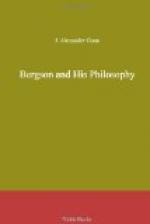it. The experiments of Kelvin and Lodge and the
discovery of radium, have brought forward a new theory
of matter; the old-fashioned base, the atom, is now
regarded as being essentially movement; matter is as
wonderful and mysterious in its character as spirit.
Further we must note that the researches of Einstein,
culminating in the formulation of his general Theory
of Relativity and his special Theory of Gravitation,
which are arousing such interest at the present time,
threaten very seriously the older static views of
the universe and seem to frustrate any efforts to
find and denote any stability therein.[Footnote:
Consult on this Dr. Einstein’s own work of which
the translation by R. W. Lawson is just published:
Relativity: The Special and the General Theory.
Methuen, 1920.] In the light of these discoveries,
Bergson’s views on the reality of Change seem
less paradoxical than they might formerly have appeared.
The reality of Change is, for Bergson, absolute, and
on this, as a fundamental point, he constructs his
thought. In conjunction with his study of Memory,
it leads up to his discussions of Real Time (la duree),
of Freedom, and of Creative Evolution. We must
then, at the outset of any study of Bergson’s
philosophy, obtain a grasp of this universal ’becoming’—a
vision of the reality of Change. Then we shall
realize that Change is substantial, that it constitutes
the very stuff of life. “There are changes,
but there are not things that change; change does
not need a support. There are movements, but there
are not, necessarily, constant objects which are moved;
movement does not imply something that is movable."[Footnote:
Translated from La Perception du Changement, Lecture
2, p. 24.]
To emphasize and to illustrate this point, so fundamental
in his thought, Bergson turns to music. “Let
us listen,” he says, “to a melody, letting
ourselves be swayed by it; do we not have the clear
perception of a movement which is not attached to
any mobility—of a change devoid of anything
which changes? The change is self-sufficient,
it is the thing itself. It avails nothing to
say that it takes time, for it is indivisible; if
the melody were to stop sooner, it would not be any
longer the same volume of sound, but another, equally
indivisible. Doubtless we have a tendency to
divide it and to represent it to ourselves as a linking
together of distinct notes instead of the uninterrupted
continuity of the melody. But why? Simply
because our auditive perception has assumed the habit
of saturating itself with visual images. We hear
the melody across the vision which the conductor of
the orchestra can have of it in looking at his score.
We represent to ourselves notes linked on to notes
on an imaginary sheet of paper. We think of a
keyboard on which one plays, of the bow of a violin
which comes and goes, of the musicians, each one of
whom plays his part in conjunction with the others.
Let us abstract these spatial images; there remains
pure change, self-sufficing, in no way attached to
a ‘thing’ which changes."[Footnote:
Translated from La Perception du Changement, pp. 24-25.]




